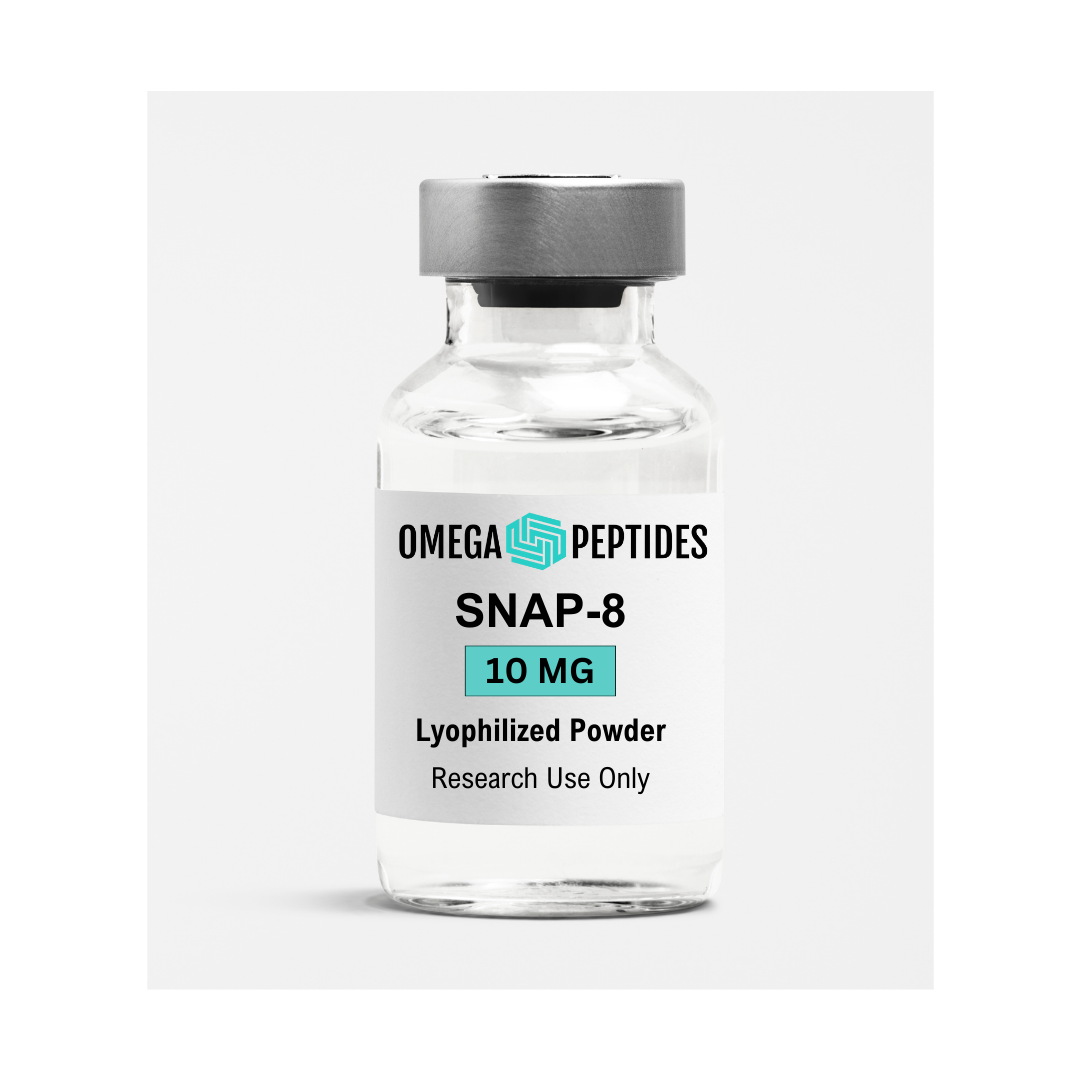Your cart is currently empty!
BUY 1 GET 1 FREE – SELECT PRODUCTS, LIMITED TIME ONLY! Enjoy FREE SHIPPING on all Orders of $200 or more.

SNAP-8 10MG – Topical
Buy SNAP-8 10mg, is a synthetic peptide of significant research interest for its ability to reduce the appearance of wrinkles and fine lines.
BUY MORE & SAVE!
Buy 5 – Get 5% discount
Buy 10 or more – Get 10% discount
Discount will automatically be applied at checkout
SNAP-8 (also known as Acetyl Octapeptide-3) is a synthetic peptide that is primarily known for its use in cosmetic and dermatological products, particularly those intended to reduce the appearance of wrinkles and fine lines. It is often compared to botulinum toxin (Botox) due to its ability to inhibit the release of neurotransmitters and reduce muscle contractions, which contributes to smoother skin. Beyond its cosmetic applications, SNAP-8 has several research use cases in various fields:
1. Neurobiology and Neurophysiology Research:
- Mechanism of Action on Neurotransmitter Release: SNAP-8 works by inhibiting the release of acetylcholine, a neurotransmitter involved in muscle contraction. Researchers use SNAP-8 to investigate the molecular and cellular mechanisms that regulate neurotransmitter release and muscle activity, which could have broader implications for understanding conditions like dystonia, spasticity, or other neuromuscular disorders.
- Neuromuscular Function: Investigating how SNAP-8 influences synaptic activity and neuromuscular junctions can help in understanding its potential therapeutic role in conditions involving overactive muscle contractions or hyperactivity of neurotransmitter release.
2. Cosmetic and Dermatological Studies:
- Anti-Aging Effects and Wrinkle Reduction: Research can focus on the clinical effects of SNAP-8 in reducing facial wrinkles and improving skin elasticity. Studies can involve its use in creams or serums to evaluate its long-term efficacy and safety in treating signs of aging. Researchers assess whether SNAP-8 can provide a non-invasive alternative to botulinum toxin for wrinkle treatment.
- Mechanism of Action in Skin Tissue: Understanding how SNAP-8 influences the skin’s underlying muscle structure and facial expression to reduce wrinkles, especially through molecular signaling pathways, could provide more insight into its broader dermatological uses.
3. Pharmacological Research:
- Neurotoxin and Peptide Therapeutics: SNAP-8’s action on the nervous system and its ability to reduce muscular contraction without the invasive properties of botulinum toxin has made it a subject of investigation for use in various medical conditions related to neuromuscular disorders. Its potential as a peptide therapeutic for conditions that require muscle relaxation is explored in preclinical and clinical trials.
- Comparison with Botulinum Toxin (Botox): Comparative studies between SNAP-8 and botulinum toxin can help researchers determine the effectiveness, side effects, duration of action, and potential medical applications for peptides like SNAP-8.
4. Inflammation and Pain Research:
- Anti-inflammatory Effects: Research has shown that SNAP-8 may have anti-inflammatory properties. Studies may investigate its potential to reduce inflammation in conditions like arthritis, muscular pain, or other inflammatory disorders.
- Pain Modulation: Due to its role in modulating neurotransmitter release, SNAP-8 could be studied in the context of pain modulation and its potential to alleviate muscle spasms or chronic pain by reducing overactivity at the neuromuscular junction.
5. Drug Delivery Systems:
- Peptide-Based Drug Delivery: The potential use of SNAP-8 in targeted drug delivery systems could be a significant research avenue. Because peptides can penetrate the skin and tissues, SNAP-8 may be incorporated into transdermal patches or other formulations for localized delivery of therapeutic agents.
6. Skin Health and Regenerative Medicine:
- Tissue Regeneration and Healing: Some studies explore the role of SNAP-8 in wound healing and tissue regeneration. Its ability to modulate muscle contractions and skin appearance can be leveraged in regenerative medicine, especially in skin wounds, scarring, and tissue repair processes.
- Cell Proliferation and Differentiation: Investigating how SNAP-8 impacts cell differentiation and proliferation in dermal fibroblasts and keratinocytes can contribute to understanding its potential in promoting healthy skin regeneration.
7. Molecular Pharmacology and Biochemistry:
- Peptide Design and Synthesis: As a synthetic peptide, SNAP-8 can be studied for its design, synthesis, and potential modification for improving its stability, bioavailability, or targeting ability. Research could also involve optimizing SNAP-8 for higher potency or specificity in neurochemical pathways.
- Enzyme Inhibition Studies: SNAP-8 can be used in studies examining its effects on enzyme systems involved in neurotransmitter release or breakdown, potentially serving as a model for other peptide-based inhibitors in pharmacology.
8. Aesthetic Medicine and Personalized Treatments:
- Biomarker Development for Skin Aging: Research on how SNAP-8 affects markers of skin aging, collagen production, and skin elasticity can lead to the development of personalized treatments for various aging skin types, leveraging peptides like SNAP-8 for more customized anti-aging solutions.
- Patient-Specific Responses: Investigating how different skin types, ages, or genetic profiles respond to SNAP-8 treatments can help optimize therapeutic approaches in aesthetic medicine, including its combination with other skin rejuvenation technologies.
Conclusion:
While SNAP-8 is primarily recognized for its cosmetic applications, its research use cases extend across neurobiology, dermatology, pharmacology, and regenerative medicine. Researchers are exploring its potential therapeutic benefits in treating neuromuscular disorders, modulating inflammation and pain, and improving skin health. Its non-invasive nature and ability to mimic botulinum toxin’s effects make it a promising subject for scientific studies and the development of peptide-based therapies.
Product Specifications
Product Notice
- Consumer is responsible for understanding chemical safety and usage requirements for this product.
- This product is for research and educational purposes only and is not intended to diagnose, cure, treat, or prevent any health condition or disease.
- This product has not been approved by the FDA for human or animal consumption and should not be used as an alternative or generic form of any FDA approved drug sharing similar chemical properties.
